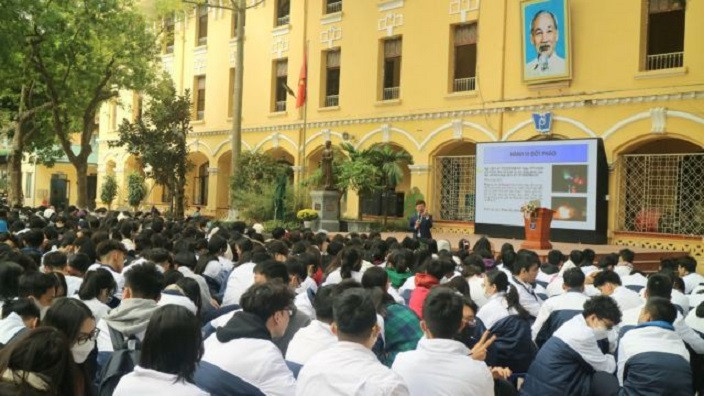
Recently, a group of juvenile delinquents armed with weapons carried out a series of robberies in the capital city.
At 3am on March 2, two young men on a yellow Honda Vision motorcycle at the intersection of Vọng - Giải Phóng Street in Đống Đa District were threatened and robbed of their motorcycle by a group of youths riding motorcycles carrying iron pipes and knives.
Around 2am on March 5, three individuals riding motorcycles with weapons threatened and robbed three young men of a black Honda Wave motorcycle on Giải Phóng Street.
On March 14, two young men riding a Honda Wave motorcycle in Lĩnh Nam Street in Hoàng Mai District were threatened and robbed of their motorcycle by a number of armed teenagers.
On March 15, surveillance footage captured six individuals riding on three motorcycles as they approached Lê Lợi Street in Hà Đông District. Around 2am, they menaced a young man riding a Honda Vision motorcycle, demanding money.
All these incidents were reported to occur at night or in the early morning and the criminals used weapons to intimidate and commit robbery.
In response to these daring and dangerous acts, Director of the Hà Nôi’s Police Department Nguyễn Hải Trung has instructed the criminal police units to urgently collaborate with the Hoàng Mai District Police to investigate and apprehend the perpetrators.
By March 16, the city’s Criminal Police Department apprehended six suspects, four of whom were 15 years old, while the remaining two were 16 years old.
On March 27, the police in Phúc Thọ District received a report from a woman who had her iPhone 15 Promax stolen by two individuals riding a Yamaha Exciter motorcycle without licence plates at Tam Hiệp Commune.
Upon receiving the information, the district police immediately launched an investigation and arrested two 17-year-olds residing in Phú Đông Commune in Ba Vì District.
This particular act occurred during daylight, further demonstrating the audacious nature of juvenile criminals.
The city’s Police Department estimated that among the criminal cases involving juveniles, more than 34 per cent of the offenders are under 16 years old, and 46 per cent are 16 or 17.
Of these, 23.5 per cent are dropouts. Over 96 per cent have no criminal record.
The police also revealed that 84 per cent of the incidents stem from personal conflicts. These individuals engage in social media activities, where they exchange insults, challenge each other, and organise gangs for crimes.
Family role
Senior Colonel Đào Trung Hiếu from the Ministry of Public Security explained that the cause may be attributed to psychological disorders during adolescence.
However, the root cause lies in adverse influences from the living environment. These children have been exposed too much to violent movies and games, and tend to unconsciously imitate the behaviours they have seen.
Another factor, he said, is the pressures of life, the struggle for livelihood, which leads many parents to lack time to care for their children. Social life is filled with temptations, weakening the bonds between family members. In such family contexts, children grow up lacking supervision, care, timely guidance from adults, making them susceptible to involvement in criminal activities.
To prevent juvenile delinquency, the city police have issued a plan to prevent crime and legal violations by minors in the city.
Colonel Nguyễn Tiến Đạt, head of the Planning Department of the Hà Nội City’s Police Department, stated that during weekends, criminal investigation units and 141 task forces disguise themselves to apprehend many juvenile suspects carrying weapons.
Although these efforts have been effective, Hiếu said the fundamental solution lies in education, focusing on nurturing human character, teaching individuals to look inward to manage themselves.
“Only through comprehensive educational solutions from families, schools, and proactive crime prevention measures from law enforcement can we effectively reduce juvenile delinquency,” he said.
Nguyễn Thị Việt Nga, member of the National Assembly's Committee on Culture and Education, stated that enhancing education and guidance is the best solution.
“There needs to be collaboration between families and schools. Families should appropriately attend to the psychological and physiological development of children. For schools, alongside teachers being more involved with students, there should be psychological counsellors to timely resolve adolescent crises,” she said.
Nga also stressed the need to strengthen legal education in schools to help adolescents realise the consequences of criminal actions. — VNS